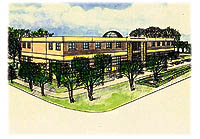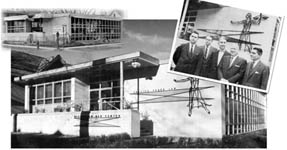![]()
Vol. 71, No. 9,
September 1998
New Facility Reflects Bar's
National Reputation of Service
By Dianne Molvig
| When the State Bar of Wisconsin moves into its
new facility in 1999, it will finally have a physical home that reflects
its first-rate national reputation for service to members, level of member
participation, product and staff quality, and commitment to the public. |
In April 1958 Philip Habermann, then State Bar executive director, sat in
the Bar's three-room rented office at 122 W. Washington Avenue, Madison,
and composed a letter in which he made a few prognostications. At the time,
the Bar was only a few months away from moving into its newly constructed
headquarters and current location at 402 W. Wilson Street. The new building
"will have been enlarged by the addition of a second story in 1970,"
Habermann predicted, "and in the year 2000 the offices will have moved
to new and larger quarters."
 Habermann wasn't off by much. A second story to the West Wilson Street
building was added in 1969, and if all goes according to plan, the Bar will
be moving into a new, larger headquarters in 1999. Habermann wasn't off by much. A second story to the West Wilson Street
building was added in 1969, and if all goes according to plan, the Bar will
be moving into a new, larger headquarters in 1999.
As State Bar Past President Steve Sorenson sees it, the new State Bar
Center will align the Bar's physical facility with its national reputation.
"The Wisconsin Bar is noted as one of the top bar associations in the
nation, in terms of its products, its staff, and its commitment to its members
and the public," Sorenson says. "But we've been chiseling away
at our strengths by the limitations imposed by the physical structure."
Greater demands placed upon the profession in an increasingly competitive
marketplace challenge the Bar to offer its members new information and efficient
ways to serve clients. These challenges have led to a new State Bar Center
- as a place to efficiently address the needs of a growing membership
and a gathering place for Wisconsin's legal community.
The new Center will be a 40,000-square-foot facility located in the American
Center Office Park near the intersection of Highway 151 and Interstate 90/94
on Madison's northeast side. The ground-breaking ceremony took place on
July 2, and the building should be ready for occupancy by next summer.
The Bar's first home
Building a new center is a major step for the Bar today, just as it was
40 years ago. In 1958 when Habermann wrote his projections, the Bar had
been in its small rented office a block off the Capitol Square for 10 years.
Before that, the Bar had had no home of its own. The Bar was founded in
1878, and during its first 42 years, its headquarters were transient, residing
in the office of whoever was serving as the association's secretary. That
arrangement continued until 1920, when the state law librarian's office
became the Bar's quarters. When Habermann came on board in 1948 as the Bar's
first employee, the time seemed right for the association to have its own
office.
Eventually that, too, proved inadequate. "We had only 2,200 members
when I opened the office," recalls Habermann, a Bar member since 1947,
who's now retired and residing in Madison. "But we were admitting 500
to 700 new lawyers a year, as a lot of the post-war classes were coming
along. By 1954 or '55, we faced the necessity of renting larger quarters
or getting a building of our own."

The Bar was formed in 1878, but it wasn't until 1958
that the association moved into its own permanent home to support 6,700
members. The decision to build an office received widespread member support
and, then as now, a capital campaign helped fund construction of the one-story
building.
Above, right: (from left) Executive Director Philip
S. Habermann, Herbert L. Terwilliger, U.S. Supreme Court Justice Tom C.
Clark, Charles L. Goldberg, and Francis J. Wilcox took part in dedicating
the current Bar Center at a ceremony in 1958.
Continuing to respond to requests for more and different
services by a growing membership, it wasn't long before the Bar needed more
space. The Bar Center underwent extensive remodeling and additional construction
over the years, finally bringing the building to its current 20,000 square
feet. As early as 10 years ago the Facilities Committee recognized the Bar
would eventually outgrow its current facility if programming were to keep
pace with its membership - now at 19,582. |
The decision for the Bar to build its own facility - at that time only
the fourth bar organization in the country to do so - won favor with
little opposition, as Habermann recalls. Others from that era also remember
the decision to build as one having widespread support. Eau Claire attorney
Francis Wilcox, a Bar member since 1933, says that owning the Bar building
"gave us a sense of solidarity and permanency." Fellow attorney
Robert B.L. Murphy of Madison, a Bar member since 1932, adds, "It meant
having a place for committees to meet, who before that had to meet in hotels
and committee members' offices. We had a place of our own. It was like owning
a home, by analogy."
The Wilson Street facility, which included some 3,400 square feet of
office space on the main floor plus a full basement, was easily more than
six times the size of the rented office Habermann and his four coworkers
had moved from. "Our staff almost rattled around in the new building,"
Habermann says, "and it was wonderful."
Benefits Habermann noticed right away included the availability of meeting
space for Bar committees and a tremendous boost in the association's capacity
to stay in touch with its then 6,700 members. New equipment for printing,
addressing, and mailing - which wouldn't have fit in the old office
- allowed the Bar to become a more effective communications hub.
Growth cycles
The staff's perception of "rattling around" didn't last long.
Within a couple of years the staff grew to be eight or 10, Habermann recalls.
Staff had expanded to serve a growing Bar membership, which took a substantial
jump when the Wisconsin Supreme Court ordered integration of the Bar in
December 1958 following a two-year trial period of integration. Thereafter,
anyone practicing law in Wisconsin had to be a Bar member. "All of
a sudden we had a membership of 6,000 or 7,000," Habermann says. "Thank
God for the new building."
 Continuing to respond to requests for more and different
services by a growing membership, it wasn't long before the Bar needed more
space. The Bar Center underwent extensive remodeling and additional construction
over the years, finally bringing the building to its current 20,000 square
feet. As early as 10 years ago the Facilities Committee recognized the Bar
would eventually outgrow its current facility if programming were to keep
pace with its membership - now at 19,582. |
By 1966, with a membership of 7,431, needs for additional parking and
interior space had become evident. In 1969 a second story was added to the
building, which had been engineered to structurally bear another floor,
and neighboring houses were purchased, razed, and replaced with parking
lots.
New continuing education programs, launched in 1970 to serve the Bar's
then 8,302 members, translated into burgeoning needs for space to store
materials, which led to construction of an underground storage room below
the rear parking lot. Other Bar programs and services also expanded. In
1981, with membership at 12,496, an addition was built, bringing the facility
to its current 20,000 square feet. Since then, the building interior has
gone through repeated cycles of remodeling and reconfiguring - plus
renting outside space for storage and printing - to accommodate a growing
Bar, now with 19,582 members, and its staff.
"It's become a honeycomb," says Stevens Point attorney Gerald
O'Brien, who chairs the Bar's Facilities Committee. "I got started
in Bar activities in the early 1980s, and back then you could get around
in there. But little by little over the years, it's become impossible. How
does anybody work in there? People's workspaces have been subdivided down
to telephone-booth size, and storage space is practically zero. To a person
who visited the Center on a regular basis over that period of time, it was
really obvious how bad it was getting."
Making cramped office space even more problematic is the nature of the
work most of the 85 full-time-equivalent State Bar employees perform, points
out Stephen Smay, executive director. "We have a high level of noise
and commotion because we have so many people crammed together," Smay
says. "A high percentage of people who work at the Bar are on the telephone,
coordinating meetings and doing things other than quietly sitting at their
desks."
Meeting and conference rooms long ago were sacrificed to create work
areas. Many meetings that once could be held at the Bar Center now have
to be convened at hotels and other locations, creating inefficiencies for
members and staff. "That involves the staff going someplace else,"
Smay notes, "and getting the materials organized to go someplace else,
and paying rental fees."
Next Page
|
